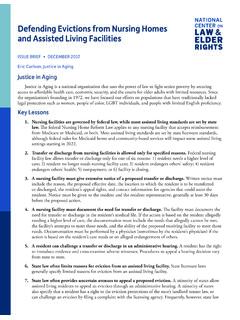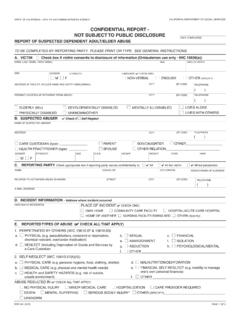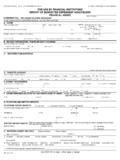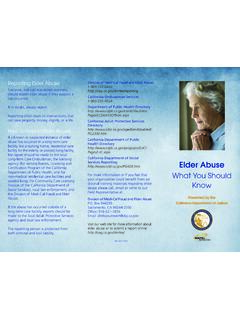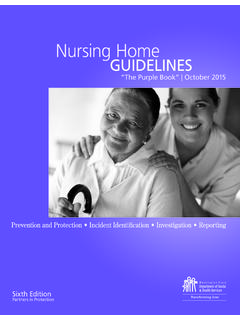Transcription of Signs of Abuse, Neglect, and Exploitation
1 Signs of abuse , Neglect, and Exploitation : The ChecklistCHAPTER SUMMARY January 2019 David Godfrey, American Bar Association Commission on Law and AgingAmerican Bar Association Commission on Law and AgingThe mission of the American Bar Association Commission on Law and Aging (ABA Commission) is to serve as the collaborative, interdisciplinary leader of the Association s work to strengthen and secure the legal rights, dignity, autonomy, quality of life, and quality of care of aging persons, particularly low-income and vulnerable elders. Since 1979, the ABA Commission has carried out this mission through research, policy development, technical assistance, advocacy, education, and Lessons1. Lawyers and others who work with older adults should be aware of Signs of physical, emotional, and behavioral abuse , neglect, or Exploitation . 2. Unexplained changes in behavior, such as fear, nervousness, or changes in emotional stability can be an indicator of a wide array of issues.
2 3. Financial Exploitation is the unauthorized theft of money or property of a person, however, not all Exploitation leaves a person unable to meet basic needs. 4. Always be observant. If something is concerning, extend the conversation and ask questions. 5. Know when to consult with Adult Protective Services, law enforcement, a social worker, or other professionals. Definitions: abuse , Neglect, and ExploitationMany state statues have state-specific definitions of abuse . elder abuse statutes generally cover adults who have a limited ability to protect themselves, and in some states, people of advanced Spotting abuse , neglect, and Exploitation is the first step to intervening and helping to restore dignity to a person. First, lawyers need to understand elder abuse . The National Center on elder abuse defines abuse as:Physical AbuseInflicting, or threatening to inflict, physical pain or injury on a vulnerable elder , or depriving them of a basic Age: Threshold Eligibility for Adult Protective Services: Comparison Chart of Criteria, By State, Lori Stiegel and Ellen Klem, American Bar Association Commission on Law and Aging.
3 Condition: Threshold Eligibility for Adult Protective Services: Comparison Chart of Criteria by State, Lori Stiegel and Ellen Klem, American Bar Association Commission on Law and Aging, Legal Basics: Signs of abuse , Neglect, and Exploitation 2 Emotional AbuseInflicting mental pain, anguish, or distress on an elder person through verbal or nonverbal AbuseNon-consensual sexual contact of any kind, or coercing an elder to witness sexual taking, misuse, or concealment of funds, property, or assets of a vulnerable or failure by those responsible to provide food, shelter, health care, or protection for a vulnerable desertion of a vulnerable elder by anyone who has assumed the responsibility of care or custody of that and Reporting Signs of abuse , Neglect, or ExploitationThis section will discuss potential Signs of abuse , neglect, or Exploitation . It is important to note these do not necessarily indicate proof of abuse , as there may be other causes.
4 Lawyers are privy to information other professions may not have access to, and should be aware of elder abuse Signs and signals in their clients. When Signs are spotted, lawyers should take appropriate action of reporting, inquiring, and offering support and help. It is important to take any self-report of abuse seriously. States vary in the reporting requirements that they place on lawyers who suspect elder abuse . All states have a mandatory reporting statute for elder abuse , however, states vary significantly in areas like: 1) who is a mandated reporter; 2) what activities require reporting; and 3) reporting when the victim resides at home or in In a forthcoming presentation, NCLER will dive in to mandatory reporting laws for suspected elder abuse . This Chapter Summary is intended to help lawyers understand and spot Signs of abuse . Please contact NCLER for a case consultation if you have questions about reporting responsibilities in your National Center on elder abuse , Frequently Asked Questions, 3 Center for Excellent in elder Law, Stetson Law, Mandatory Reporting Law Statutes, Legal Basics: Signs of abuse , Neglect, and Exploitation 3 Signs of Physical or Sexual AbuseLawyers and others working with older adults should be observant and look for Signs of abuse .
5 The checklist below details signals, such as injuries, emotional states, or changes in behavior, that lawyers should watch out for. Items in italics indicate the Signs that attorneys are well-positioned to observe. Keep this checklist in mind, and if anything raises a doubt, ask more questions, or report the suspicion to adult protective services or other of Physical or Sexual AbusePHYSICAL Signs Bruises Scratches abrasions Broken bones or sprains Circular or round burns Redness or scalding of the skin, especially on the back, bottom of the legs, buttocks, back of the arms Ligature marks on the wrists, ankles, or around the waist Signs of malnutrition or dehydration Repeated injuries Over or undermedication Broken or missing eyeglasses or denturesBEHAVIORAL OR EMOTIONAL Signs Refusal by family or caregivers to allow the person to be alone with you Dynamics of power and control4 Emotional discomfort with the presence of a person or when talking about a person Frequent emergency room visits Reluctance to seek medical care for injuries Dismissive explanation of injuries, such as.
6 I must have bumped into the table or he must have walked into the wall Isolation of the person by family, friends or caregivers, changes in social contacts Unexplained changes in behavior such as withdrawal Signs of fear (especially of a particular person) Changes in clothing that may suggest covering up injuries (suddenly wearing long sleeve shirts in the middle of summer) Living in a setting that limits the person s ability to move about or communicate4 See National Coalition Against Domestic Violence, Dynamics of abuse , Basics: Signs of abuse , Neglect, and Exploitation 4 Sexual AbusePHYSICAL Signs (Talk with caregivers who may observe these Signs .) Bruises around the breasts or genitals Torn or bloody clothing or bedding Unexplained vaginal or anal bleeding Sexually transmitted infectionsBEHAVIORAL OR EMOTIONAL Signs Inappropriate interactions between the person and caregivers, friends, or family members Behavioral changes such as withdrawal, or fear, sudden changes in emotional state, or aggressionEmotional abuse ALL BEHAVIORAL OR EMOTIONAL Signs Isolation by caregiver or family members Nervous or fearful behavior (especially around specific persons)
7 Changes in behavior, such as withdrawal or fear Behaviors such as rocking, biting, thumb sucking, mumbling to themselves Inappropriate emotional responses, or changes in emotional responses Withdrawal from social activities Depression, changes in sleep patterns Behavior of others that is aggressive, or demeaning, or short tempered Unexpected or seemingly unwilling compliance, or behavior Legal Basics: Signs of abuse , Neglect, and Exploitation 5 Signs of NeglectThe Signs of self-neglect and caregiver-neglect are largely the same. Caregiver-neglect is neglect by someone who has a legal or moral obligation to meet the needs of a person who is dependent on the caregiver, and it is a legal issue with social work solutions. Self-neglect is a social services issue, unless the person lacks the ability to understand their actions, or the self-neglect behavior results in code violations or hoarding.
8 Code violations and hoarding become legal issues that also require social service and mental health interventions. Items in italics indicate the Signs that attorneys are well-positioned to of NeglectBEHAVIORAL AND EMOTIONAL Signs Dirty or unkempt appearance Missing or broken eyeglasses, dentures, or hearing aids Complaints to or citations from code enforcement about living conditions Utility disconnects Unsafe or inappropriate housing Missed appointments Dirty, excessively worn or seasonally inappropriate clothing Sudden unexplained weight loss, loss of appetite, dehydration No or inappropriate food in the home Unable to prepare food lack of access to appropriate nutrition Untreated illness, chronic condition or injury Needed or missing durable medical equipment such as canes, walkers, wheelchairs Lack of appropriate heating or air-conditioning Frostbite or heat exhaustion Bedsores Soiled diapers Unusually dirty or cluttered living environment (look for a major change in cleanliness or clutter) Insect infestation, rodent infestation Mold, mildew, or other environmental hazards Person in need of care, left alone for extended periods of time, or left alone in a public place Legal Basics: Signs of abuse , Neglect, and Exploitation 6 Signs of Financial ExploitationA lot of financial abuse appears at first as an unmet need, or a request for assistance.
9 When responding to requests for help, it is important to ask questions beyond the immediate need. Not all Exploitation results in leaving the person unable to meet their basic needs. Nothing replaces a kind and thoughtful review of the person s income and spending. A close review of bank records, credit card statements, and investment statements can reveal unusual or unexplained activity. If a caregiver or third party is shopping for the person, they should keep detailed receipts of expenditures, and these receipts should be carefully reviewed by other caregivers or advocates. Online shopping should be reviewed to assure that the items purchased are for the use or benefit of the person. Advocates should ask the older adult how their money is managed. If the older adult is surprised by running out money, or if they regret any recent financial decisions, the advocate should further scrutinize the older adult s financial records.
10 Start by asking if anyone else has access to their money or property, and if they have noticed anything unusual or anything missing. Technology and financial services industry advances are making it easier to spot potential Signs of financial Exploitation . With online access to financial records, and permission from the older adult to obtain these records, the advocate can easily review information. Many financial institutions have established review only access for accounts, which allow trusted third parties oversight. Some state statutes also allow for law enforcement or APS to access financial records in some circumstances. Items in italics indicate the Signs that attorneys are well-positioned to observe. Signs of Financial Exploitation Unmet needs, or unpaid expenses, despite seemingly adequate income and assets Seeking help with meeting basic needs such as food, shelter, clothing Missing financial statements Unusual banking activity Unusual or unauthorized credit card use Wire transfers Adding names to financial accounts Changing agent on a power of attorney, or documents missing Sudden or unexplained changes in estate plans Missing personal property Unusual debit or ATM card usage Paying for services or goods that do not get provided or recieved Checks payable to cashLegal Basics.






